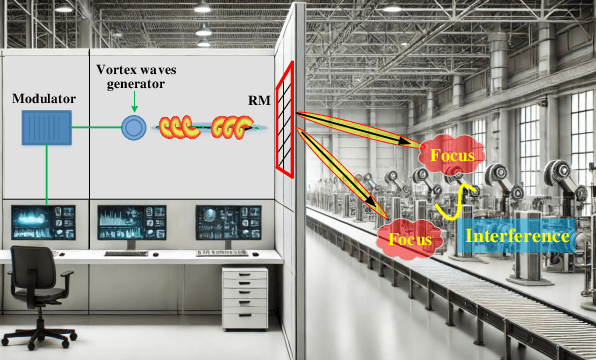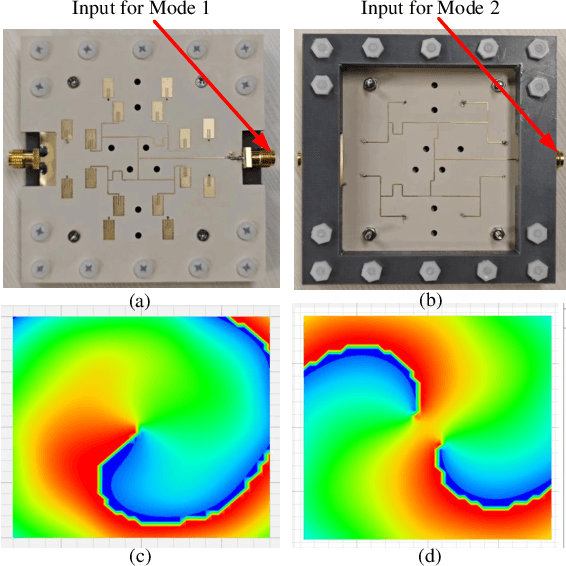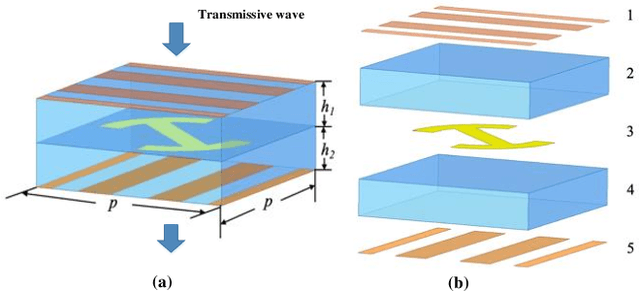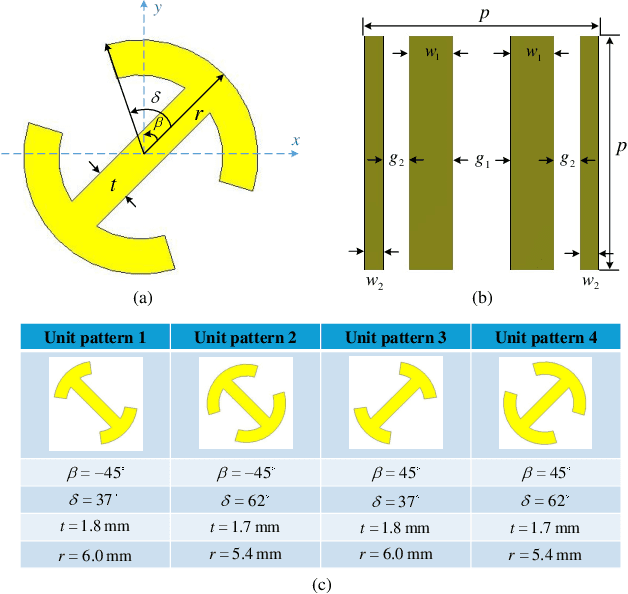Yufei Zhao
QMBench: A Research Level Benchmark for Quantum Materials Research
Dec 19, 2025Abstract:We introduce QMBench, a comprehensive benchmark designed to evaluate the capability of large language model agents in quantum materials research. This specialized benchmark assesses the model's ability to apply condensed matter physics knowledge and computational techniques such as density functional theory to solve research problems in quantum materials science. QMBench encompasses different domains of the quantum material research, including structural properties, electronic properties, thermodynamic and other properties, symmetry principle and computational methodologies. By providing a standardized evaluation framework, QMBench aims to accelerate the development of an AI scientist capable of making creative contributions to quantum materials research. We expect QMBench to be developed and constantly improved by the research community.
Enhanced Information Security via Wave-Field Selectivity and Structured Wavefront Manipulation
Dec 11, 2025Abstract:In this paper, we propose a novel secure wireless transmission architecture that enables the co-existence of spatial field modulation (SFM) and digital bandpass modulation (DBM), utilizing multi-mode vortex waves and programmable meta-surfaces (PMS). Distinct from conventional joint modulation schemes, our approach establishes two logically independent transmission channels--SFM and DBM--thereby eliminating the need for joint signal design or time synchronization. Specifically, the orthogonality of vortex wave modes is exploited to construct a high-capacity multi-mode DBM channel, in which each mode carries modulated symbols independently. As the composite waveform passes through the PMS, energy from different vortex modes is spatially focused onto distinct positions, dynamically determined by the PMS configuration. This spatial mapping forms a unique lookup table that encodes additional information in the electro-magnetic (EM) field distribution, effectively enabling a second, concurrent SFM channel. To enhance physical-layer security, the DBM channel transmits encrypted symbols transformed via dynamic symbol-domain mapping, while the corresponding mapping relations--or key information--are carried by the SFM channel. This lightweight dual-channel encryption strategy provides strong confidentiality without requiring complex joint decoding. To validate the feasibility of the proposed architecture, we design and implement a proof-of-concept prototype system, and conduct experimental demonstrations under real-world wireless communication conditions. The experimental results confirm the effectiveness of the co-existent DBM-SFM design in achieving reliable and secure transmission. The proposed architecture offers a scalable, low-complexity, and secure transmission solution for future IoT networks, especially in scenarios demanding both spectral efficiency and physical-layer confidentiality.
Compact Varactor-Integrated RIS for Wideband and Continuously Tunable Beamforming
May 08, 2025Abstract:This letter presents a novel Reconfigurable Intelligent Surface (RIS) that features a low-profile structure, wide operating bandwidth, and continuous phase control. By incorporating a middle patch layer without introducing an additional air gap, the proposed design maintains a thin form factor, while achieving a smooth 310{\deg} phase shift over 10\% bandwidth at 6.1 GHz with excellent reflection. A fabricated 10*10 RIS array exhibits stable performance, enabling precise beam control across a 600 MHz bandwidth. These results highlight the potential of the proposed low-profile, wideband RIS with continuous phase tuning for next-generation wireless communication systems.
Low-Interference Near-Field Multi-User Communication Enabled by Spatially Converging Multi-Mode Vortex Waves
Feb 18, 2025



Abstract:This paper proposes a multi-user Spatial Division Multiplexing (SDM) near-field access scheme, inspired by the orthogonal characteristics of multi-mode vortex waves. A Reconfigurable Meta-surface (RM) is ingeniously employed as the gateway for information transmission. This RM not only receives spatially overlapping multiplexed multi-mode vortex beams but also converts them into focused point beams in the near field. Specifically, a multi-port microstrip array method is utilized to generate multiple orthogonal vortex electromagnetic wave modes. Different ports serve as feeding points for baseband signals, allowing independent modulated data to be flexibly loaded onto different modes. After being adjusted by the RM, the vortex electromagnetic waves are converted into energy-focusing point beams, which can be directed to arbitrary 3D positions in the RM's near-field region and received by different users. Since the spatial positions of the point beams are non-overlapping, this approach not only ensures energy concentration but also significantly reduces inter-user interference. Near-field scanning results in a microwave anechoic chamber validate the effectiveness of this method, while real-time communication demonstrations confirm the system's capability for low-interference information multiplexing and transmission in practical scenarios.
Joint Precoder and Reflector Design for RIS-assisted Multi-user OAM Communication Systems
Jan 24, 2025



Abstract:Orbital angular momentum (OAM) can enhance the spectral efficiency by multiplying a set of orthogonal modes on the same frequency channel. To maintain the orthogonal among different OAM modes, perfect alignments between transmitters and receivers are strictly required. However, in multi-user OAM communications, the perfect alignments between the transmitter and all the receivers are impossible. The phase turbulence, caused by misaligned transmitters and receivers, leads to serious inter-mode interference, which greatly degrades the capacity of OAM transmissions. To eliminate the negative effects of phase turbulence and further enhance the transmission capacity, we introduce RIS into the system, and propose a joint precoder and reflector design for reconfigurable intelligent surface (RIS)-assisted multi-user OAM communication systems. Specifically, we propose a three-layer design at the transmitter side, which includes inter-user OAM mode interference cancellation, inter-mode self-interference elimination and the power allocation among different users. By analyzing the characteristics of the overall channels, we are able to give the specific expressions of the precoder designs, which significantly reduce the optimization complexity. We further leverage RIS to guarantee the line-ofsight (LoS) transmissions between the transmitter and users for better sum rate performance. To verify the superiority of the proposed multi-user OAM transmission system, we compare it with traditional MIMO transmission schemes, numerical results have shown that our proposed design can achieve better sum rate performance due to the well-designed orthogonality among different users and OAM modes.
Harnessing Rydberg Atomic Receivers: From Quantum Physics to Wireless Communications
Jan 21, 2025Abstract:The intrinsic integration of Rydberg atomic receivers into wireless communication systems is proposed, by harnessing the principles of quantum physics in wireless communications. More particularly, we conceive a pair of Rydberg atomic receivers, one incorporates a local oscillator (LO), referred to as an LO-dressed receiver, while the other operates without an LO and is termed an LO-free receiver. The appropriate wireless model is developed for each configuration, elaborating on the receiver's responses to the radio frequency (RF) signal, on the potential noise sources, and on the system performance. Next, we investigate the association distortion effects that might occur, specifically demonstrating the boundaries of linear dynamic regions, which provides critical insights into its practical implementations in wireless systems. Extensive simulation results are provided for characterizing the performance of wireless systems, harnessing this pair of Rydberg atomic receivers. Our results demonstrate that they deliver complementary benefits: LO-free systems excel in proximity operations, while LO-dressed systems are eminently suitable for long-distance sensing at extremely low power levels. More specifically, LO-dressed systems achieve a significant signal-to-noise ratio (SNR) gain of approximately 44 dB over conventional RF receivers, exhibiting an effective coverage range extension over conventional RF receivers by a factor of 150. Furthermore, LO-dressed systems support higher-order quadrature amplitude modulation (QAM) at reduced symbol error rates (SER) compared to conventional RF receivers, hence significantly enhancing wireless communication performance.
Experimental Study of RCS Diversity with Novel No-divergent OAM Beams
Dec 25, 2024



Abstract:This research proposes a novel approach utilizing Orbital Angular Momentum (OAM) beams to enhance Radar Cross Section (RCS) diversity for target detection in future transportation systems. Unlike conventional OAM beams with hollow-shaped divergence patterns, the new proposed OAM beams provide uniform illumination across the target without a central energy void, but keep the inherent phase gradient of vortex property. We utilize waveguide slot antennas to generate four different modes of these novel OAM beams at X-band frequency. Furthermore, these different mode OAM beams are used to illuminate metal models, and the resulting RCS is compared with that obtained using plane waves. The findings reveal that the novel OAM beams produce significant azimuthal RCS diversity, providing a new approach for the detection of weak and small targets.This study not only reveals the RCS diversity phenomenon based on novel OAM beams of different modes but also addresses the issue of energy divergence that hinders traditional OAM beams in long-range detection applications.
Innovative RIS Prototyping Enhancing Wireless Communication with Real-Time Spot Beam Tracking and OAM Wavefront Manipulation
Jul 28, 2024Abstract:This paper presents a sophisticated reconfigurable metasurface architecture that introduces an advanced concept of flexible full-array space-time wavefront manipulation with enhanced dynamic capabilities. The practical 2-bit phase-shifting unit cell on the RIS is distinguished by its ability to maintain four stable phase states, each with ${90^ \circ }$ differences, and features an insertion loss of less than 0.6 dB across a bandwidth of 200 MHz. All reconfigurable units are equipped with meticulously designed control circuits, governed by an intelligent core composed of multiple Micro-Controller Units (MCUs), enabling rapid control response across the entire RIS array. Owing to the capability of each unit cell on the metasurface to independently switch states, the entire RIS is not limited to controlling general beams with specific directional patterns, but also generates beams with more complex structures, including multi-focus 3D spot beams and vortex beams. This development substantially broadens its applicability across various industrial wireless transmission scenarios. Moreover, by leveraging the rapid-respond space-time coding and the full-array independent programmability of the RIS prototyping operating at 10.7 GHz, we have demonstrated that: 1) The implementation of 3D spot beams scanning facilitates dynamic beam tracking and real-time communication under the indoor near-field scenario; 2) The rapid wavefront rotation of vortex beams enables precise modulation of signals within the Doppler domain, showcasing an innovative approach to wireless signal manipulation; 3) The beam steering experiments for blocking users under outdoor far-field scenarios, verifying the beamforming capability of the RIS board.
MRIo3DS-Net: A Mutually Reinforcing Images to 3D Surface RNN-like framework for model-adaptation indoor 3D reconstruction
Jul 16, 2024Abstract:This paper is the first to propose an end-to-end framework of mutually reinforcing images to 3D surface recurrent neural network-like for model-adaptation indoor 3D reconstruction,where multi-view dense matching and point cloud surface optimization are mutually reinforced by a RNN-like structure rather than being treated as a separate issue.The characteristics are as follows:In the multi-view dense matching module, the model-adaptation strategy is used to fine-tune and optimize a Transformer-based multi-view dense matching DNN,so that it has the higher image feature for matching and detail expression capabilities;In the point cloud surface optimization module,the 3D surface reconstruction network based on 3D implicit field is optimized by using model-adaptation strategy,which solves the problem of point cloud surface optimization without knowing normal vector of 3D surface.To improve and finely reconstruct 3D surfaces from point cloud,smooth loss is proposed and added to this module;The MRIo3DS-Net is a RNN-like framework,which utilizes the finely optimized 3D surface obtained by PCSOM to recursively reinforce the differentiable warping for optimizing MVDMM.This refinement leads to achieving better dense matching results, and better dense matching results leads to achieving better 3D surface results recursively and mutually.Hence, model-adaptation strategy can better collaborate the differences between the two network modules,so that they complement each other to achieve the better effect;To accelerate the transfer learning and training convergence from source domain to target domain,a multi-task loss function based on Bayesian uncertainty is used to adaptively adjust the weights between the two networks loss functions of MVDMM and PCSOM;In this multi-task cascade network framework,any modules can be replaced by any state-of-the-art networks to achieve better 3D reconstruction results.
SFC: Achieve Accurate Fast Convolution under Low-precision Arithmetic
Jul 03, 2024Abstract:Fast convolution algorithms, including Winograd and FFT, can efficiently accelerate convolution operations in deep models. However, these algorithms depend on high-precision arithmetic to maintain inference accuracy, which conflicts with the model quantization. To resolve this conflict and further improve the efficiency of quantized convolution, we proposes SFC, a new algebra transform for fast convolution by extending the Discrete Fourier Transform (DFT) with symbolic computing, in which only additions are required to perform the transformation at specific transform points, avoiding the calculation of irrational number and reducing the requirement for precision. Additionally, we enhance convolution efficiency by introducing correction terms to convert invalid circular convolution outputs of the Fourier method into effective ones. The numerical error analysis is presented for the first time in this type of work and proves that our algorithms can provide a 3.68x multiplication reduction for 3x3 convolution, while the Winograd algorithm only achieves a 2.25x reduction with similarly low numerical errors. Experiments carried out on benchmarks and FPGA show that our new algorithms can further improve the computation efficiency of quantized models while maintaining accuracy, surpassing both the quantization-alone method and existing works on fast convolution quantization.
 Add to Chrome
Add to Chrome Add to Firefox
Add to Firefox Add to Edge
Add to Edge